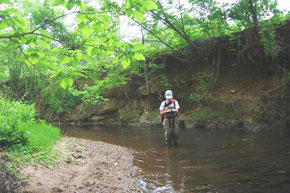Total maximum daily loads (TMDL)
Total Maximum Daily Load (TMDL) is the amount of pollution that a river or stream can handle before negative impacts occur to water quality. If a water body contains more contamination than allowed by water quality standards, the water body is considered "impaired". In most cases, a cleanup plan (aka TMDL Action Plan) must be developed and implemented to restore impaired waters. The Virginia Department of Environmental Quality maintains an impaired waters list and is responsible for issuing TMDL reports that describe the likely sources of pollutants which caused the impairment, estimate the existing load of the pollutant in the stream, and allocate a load reduction required to restore the health of the stream.
The following table summarizes impaired waters that receive runoff from the University’s main grounds and that have TMDLs developed.
| Watershed | Impairment | Stressor |
|---|---|---|
| Chesapeake Bay | Dissolved Oxygen, Chlorophyll a, Water Clarity/Underwater Grasses | Sediment, Nitrogen, Phosphorus |
| Rivanna River | Benthic Invertebrates | Sediment |
| Rivanna River Mainstream, North Fork Rivanna River, Preddy Creek & Tributaries, Meadow Creek, Mechums River, and Beaver Creek | Bacteria | Bacteria (E. coli) |
| Meadow Creek, Schenks Branch, Moores Creek, and Lodge Creek | Benthic Invertebrates | Sediment |
A benthic invertebrate impairment means that the water bugs living in the stream are absent or not thriving due to the quantity of sediment in the stream bed. When there is too much sediment in the stream bed, it fills in the spaces between the bigger rocks where the bugs normally live. These bugs are normally a source of food for fish and other aquatic life, so the overall health of stream depends on these bugs being able to thrive and reproduce. Excessive sediment is generated by poorly controlled construction sites and erosion of stream banks from high runoff rates off impervious surfaces. Bacteria impairments make streams unsafe for fishing, swimming, or other recreational activities and can originate from sources such as pet waste and failing septic systems.

TMDL requirements
In accordance with its MS4 permit (link to MS4 page) the University has prepared the TMDL Action Plans listed below. These plans describe the nature of the impairment, required pollutant load reductions, and steps the University has already taken and plans to take in the future to achieve the reductions.
